Menu
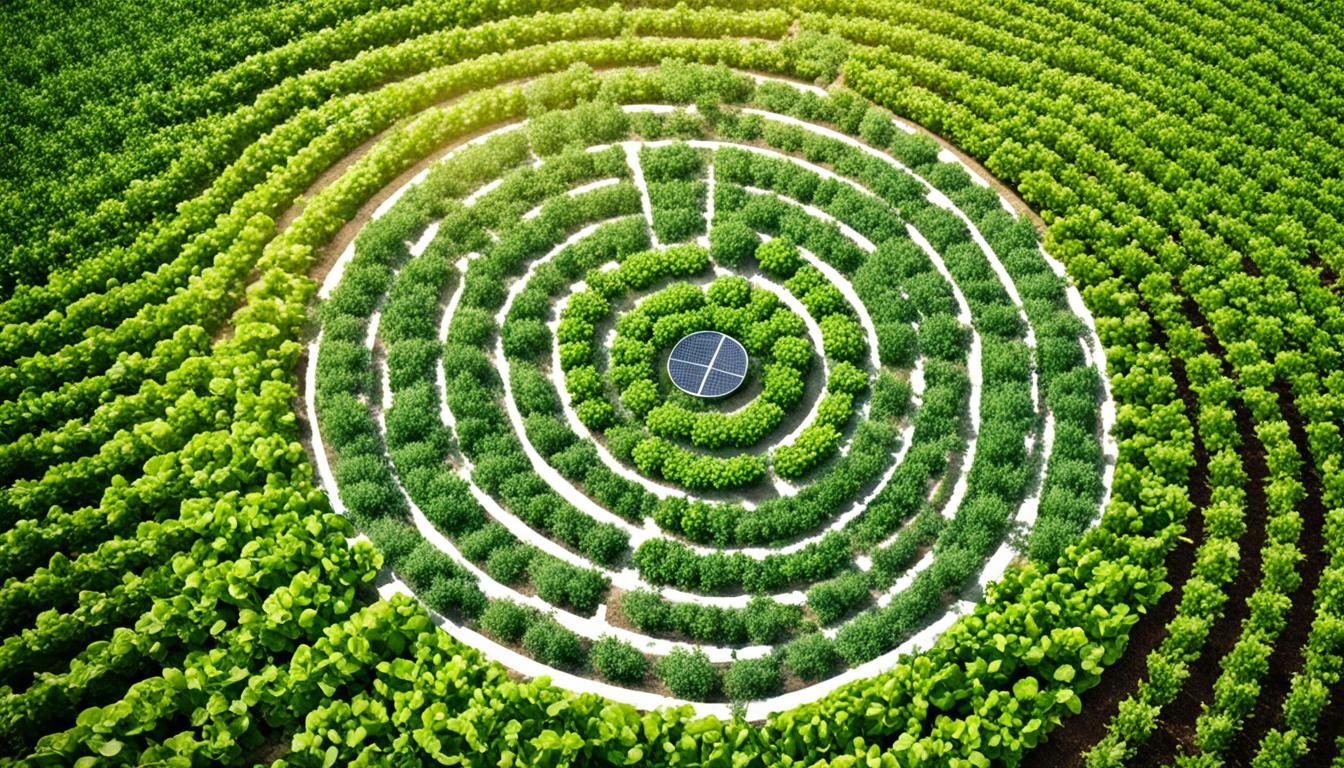
Did you know a cycle of crop rotation often takes up to eight years? This shows how deep and complex this farming practice is. It’s really vital for farming that’s good for the planet. Crop rotation doesn’t just keep the soil healthy and lower weed growth. It also means farmers can use less chemicals on their crops.
Farmers grow different crops in turns on the same piece of land. This is great for the environment and also boosts their harvests. Today, thanks to technology, keeping track of what works best is easier. This has led to more farmers doing crop rotation to help the earth and grow more food.
Crop rotation is the opposite of monocropping. It means planting different crops in a sequence on the same plot. This method helps keep the soil fertile and nutrient levels balanced. It’s vital for organic farming, keeping the soil healthy and controlling pests. But, it needs careful planning to avoid problems like diseases and too little or too much of certain nutrients.
If crop rotation is done wrong, problems show up after a few years. This can even surprise experienced farmers. Organic farmers change what they plant more often than others, avoiding recurring problems with their crops. Planning a rotation for a farm with lots of crop choices is very complex. For instance, a farm with ten crops could have over 5,000 different four-year planting sequences.
Choosing which crops to plant next isn’t always easy. This task gets harder when you add factors like the type of soil and if there’s enough water. A rotation plan might cover up to eight years and include from a few plants to dozens of different plant types.
Growing crops that leave lots of plant material, like maize and hay, can help stop soil from washing away. Crop rotation also shapes the soil in ways that help plants grow better. It’s key to making farming strong and resilient, says a study by Li et al. (2019).
Rotating crops can cut down on the need for artificial fertilisers. It makes the soil rich and stops pests from becoming a big problem. This information comes from Mohler and Johnson in 2009. So, crop rotation is not just good for the land, but for the wider environment as well.
Crop rotation even helps use water better by keeping the soil healthy. But, it’s important to learn how to do it right. Doing it the wrong way can harm the land. Knowing how crop rotation fits into good farming methods is essential for the land to stay fertile for a long time.
Seasonal crop rotation is vital for sustainable farming. It means choosing plants that thrive in each season. Farmers plant different crops at different times to help them grow better. This boosts soil health and the amount of food grown. It also helps crops fight off diseases and use soil nutrients well.
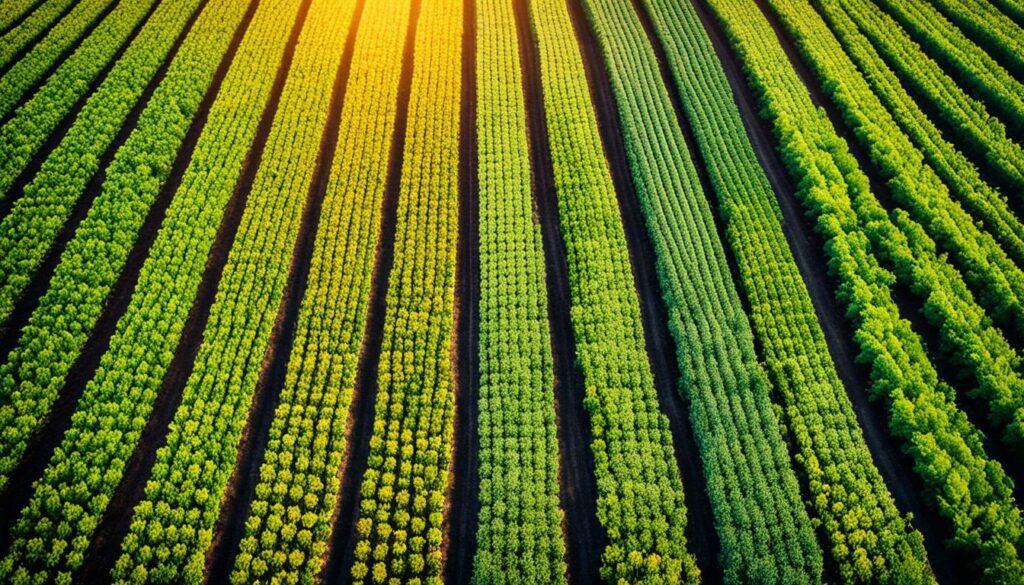
Effective crop rotation involves knowing what each crop needs to grow best. For example:
Farmers use the changing seasons to pick the right crops and help them grow strong. This boosts a plant’s ability to fight disease due to them being in their best climate. A full rotation cycle can last eight years and includes several different crops. This variety doesn’t just help the soil but also makes the farm’s ecosystem more stable.
Keeping a detailed planting and rotation chart is key for managing seasonal rotation. It’s vital for keeping the soil healthy, dealing with pests and weeds, and getting the best harvests. Research from the journal Agronomy for Sustainable Development (2019) shows how this type of rotation can make the farm stronger.
| Crop Family | Optimal Season | Soil Requirement |
|---|---|---|
| Alliums (Onions, Garlic) | Spring, Autumn | Well-Drained Soil |
| Cucurbits (Squash, Cucumbers) | Summer | Nutrient-Rich Soil |
| Nightshades (Tomatoes, Peppers) | Summer | Rich Soil |
| Umbellifers (Carrots, Parsley) | Varied Planting Times | Moist Soil |
| Legumes (Green Beans, Peas) | Early Spring | Fix Nitrogen in Soil |
Crop rotation does more than just change crops in a field. It keeps soil rich and healthy by mixing up nutrients in the earth. This process helps the soil stay good for planting over and over, making farming better for the planet.
Besides, crop rotation can help soil to grow better plants. When we switch what we plant in a field, it makes the soil work better for different crops. This idea means farmers can grow more food and keep their fields healthy, according to Li et al. (2019).
Using legumes in crop rotation is great for soil. They can add nitrogen to the soil, needing less man-made fertilisers. This means the next crops get a better start, growing healthier and stronger.
Rotating crops makes the earth better structured. Each type of plant helps grow soil that holds water better and stops erosion, as shown by Jankauskas and Jankauskiene (2003). This also means less water is needed for farming.
“Implementing crop rotation can be instrumental in renewing soil nutrients, reducing the need for fertilisers, and enhancing crop health through balanced soil fertility.”
Growing different crops at different times helps farmers grow more food. It also means the soil gets a chance to rest and get its nutrients back. This way of farming is good for the earth and the people who farm.
| Crop Rotation Benefit | Impact on Soil Fertility | Study |
|---|---|---|
| Legume Integration | Nitrogen Fixation: 50-200 lbs/acre | Mohler and Johnson (2009) |
| Diverse Crop Systems | Improved Soil Structure | Ball et al. (2005) |
| Erosion-Preventive Rotations | Ecological Stability | Jankauskas and Jankauskiene (2003) |
| Long-Term Rotation Cycles | Sustainable Fertility | Li et al. (2019) |
Crop rotation does a lot more than boost harvests. It’s vital for stopping soil erosion in its tracks. This is key for keeping farming sustainable. A big plus of crop rotation: it uses different plant roots. These roots naturally improve soil by making it less likely to erode. This keeps the topsoil strong, which is necessary for healthy plants to grow.
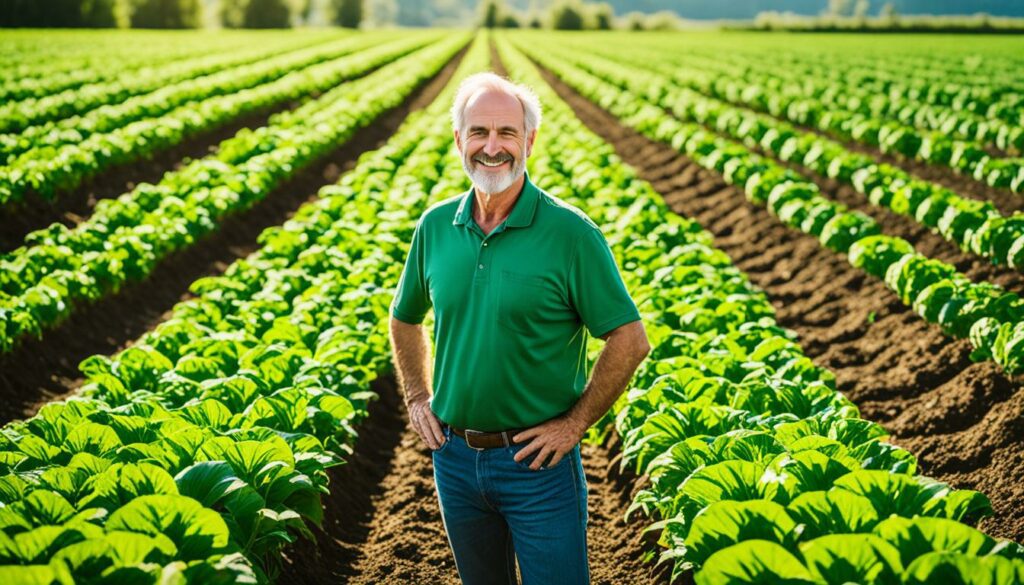
Crop rotation mixes plants with shallow and deep roots. This makes the soil stronger. Plants with shallow roots hold the topsoil in place. Meanwhile, deep-rooting plants like alfalfa can reach deep, breaking up compacted layers. This makes the soil more able to absorb water and nutrients. In turn, it stops erosion and improves soil health.
High-residue plants like maize are another benefit of crop rotation. They add organic matter to the soil and protect it from erosion. Crop rotation also includes using plants that cover the soil all year. For instance, it might involve using grasses and cover crops. They add more organic matter and help the soil resist erosion better.
Crop rotation even reduces the need for fertilisers and pesticides. This cuts costs and boosts soil health. And the best part? It doesn’t cost much to do crop rotation. Yet, it’s a great way to farm sustainably.
| Benefits | Impact |
|---|---|
| Prevention of Soil Erosion | Utilising varied root systems and high-residue plants to protect soil |
| Improved Soil Health | Enhanced structure and nutrient profile through crop diversity |
| Cost-Effective | Reduction in fertiliser and pesticide usage |
Crop rotation boosts yields and helps manage risks. It makes the soil more fertile and structured. Less erosion happens, which is good for the land. Plants interact with the soil over up to eight years. This time helps create the best conditions for growth.
Crop rotation increases a plant’s ability to tackle tough times. This includes not only drought or cold, but also bad soil. By changing what’s grown, the soil’s nutrients stay balanced. Every new crop benefits from what the last one left behind. For instance, at Iowa State University, alternating crops every three to four years boosts corn and soybean harvests. It also makes the soil healthier and cuts down on erosion significantly.
Moving crops around on the farm helps tackle many risks. It stops pests and diseases getting too comfortable. This way, fewer chemical sprays are needed to fight weeds and bugs. Using different crops makes the whole farm stronger. It also lessens the need for synthetic chemicals, saving money. The Natural Resources Conservation Service lends a hand with the know-how. They help farmers plan the best crop rotations for healthy soil and farms.
| Benefits | Details |
|---|---|
| Yield Boost | Higher crop yields due to improved soil fertility and structure. |
| Risk Management | Effective disruption of pests and diseases, and reduced reliance on chemical inputs. |
| Economic Benefits | Reduction in fertiliser and pesticide costs, and improved farm profitability. |
| Sustainability | Enhanced ecological balance and long-term soil health. |
Effective crop rotation strategies are key to better nutrient uptake. It leads to big benefits from rotating crops. This method means planting different crops one after the other. Some farms keep it simple with just a few crops. But others mix in twelve or more. Crop rotation boosts soil health. It makes sure plants get all the nutrients they need.
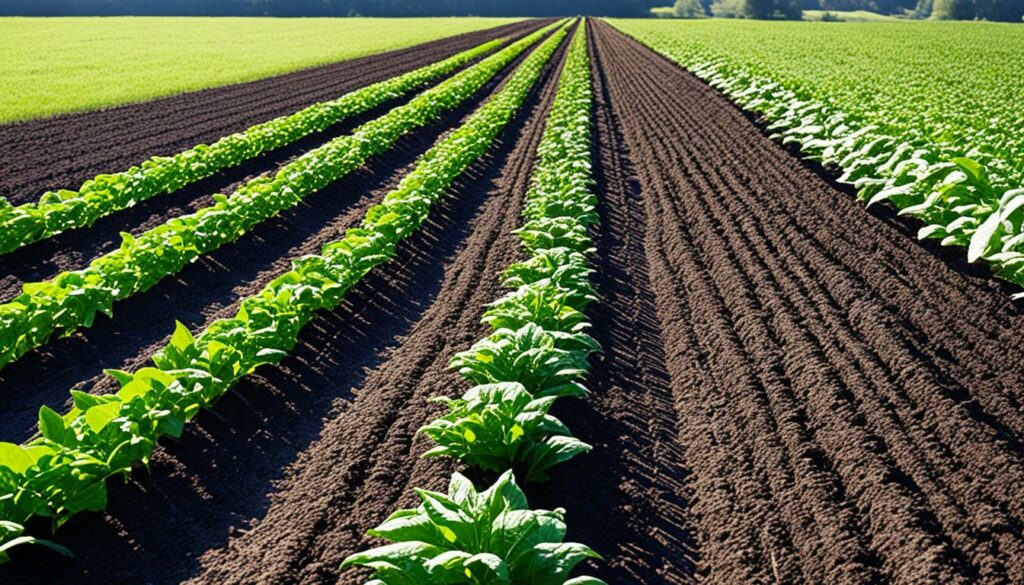
Crop rotation helps a lot with getting nitrogen into the soil. This is done by including legumes in the mix. Legumes can capture nitrogen from the air, and put it in the soil. They do this without needing much help from man-made fertilisers. By picking the right mix of crops, the soil stays rich in all kinds of nutrients.
Legumes can add tons of nitrogen to every acre. This is a big help for the next set of crops that come along.
Crop rotation balances deep-rooted and less-hungry plants. Deep-rooted types pull up nutrients from deep down. This helps the soil and plants grow strong. So, they improve how well the soil can absorb nutrients. On the other hand, plants that don’t need as much can grow without taking too much from the soil. This helps keep everything in good balance. The result is healthier soil and better crops.
This method boosts not just nutrient intake but also many other factors. By rotating their crops well, farmers can keep the soil, yield, and sustainability in top shape. It helps build a farming system that lasts a long time.
Keeping pests and diseases under control is vital for good crop health. It also helps keep farming methods sustainable. Farming can be healthier if farmers rotate crops. This disrupts pest life cycles and cuts the use of chemical pesticides.
Crop rotation disrupts pest life cycles effectively. It’s also a low-cost method. Success depends on knowing the pest’s life cycle. Pests can survive in soil for years, affecting how well rotation works for controlling diseases.
Some diseases subside with crop rotation. But, if a disease can live for a while in soil, rotation must be longer. WSU suggests 5 to 7 years of rotating crops by their plant families for the best pest control. At least every 3 years, a rotation is needed to combat pests and diseases effectively.
Less pesticide use can make farming more sustainable and keep plants healthier. Insects like ladybugs and lacewings can eat pests. Farmers help these insects by using fewer pesticides and creating places for them to live.
Farmers must also prevent pests and diseases from coming back. They should avoid using infected seeds or moving soil with diseases. Weeds that carry diseases, like Pythium and Fusarium, need special attention. They are tough to fight which is why careful crop rotation planning is crucial.
WSU Extension has many resources for pest and disease management, such as Hortsense and Pestsense. Their publications, like EM057E and EM067E, are useful. They help farmers refine their crop rotation plans and lower pesticide use successfully.
Using crop rotation as a strategy helps cut down on weeds by changing the environment. This change affects weed growth cycles, leading to fewer weeds of concern. While there may be more types of weeds, the total amount is good for farming without chemicals.
A good crop rotation system can really help with weed management by changing the field’s dynamics. This means the cycles of problem weeds are disturbed. So, you see fewer bad weeds. This way of farming is much better for the land long-term.
In northern Pennsylvania, a farm cut out most of its weeds by planting different crops and using cover crops. They also left some land bare in the summer. They grew things in both spring and autumn to fight off weeds well. Information about Weeds and Crop Rotations is Available Here. Grain and legume cover crops were especially good at this, showing how varied planting helps.
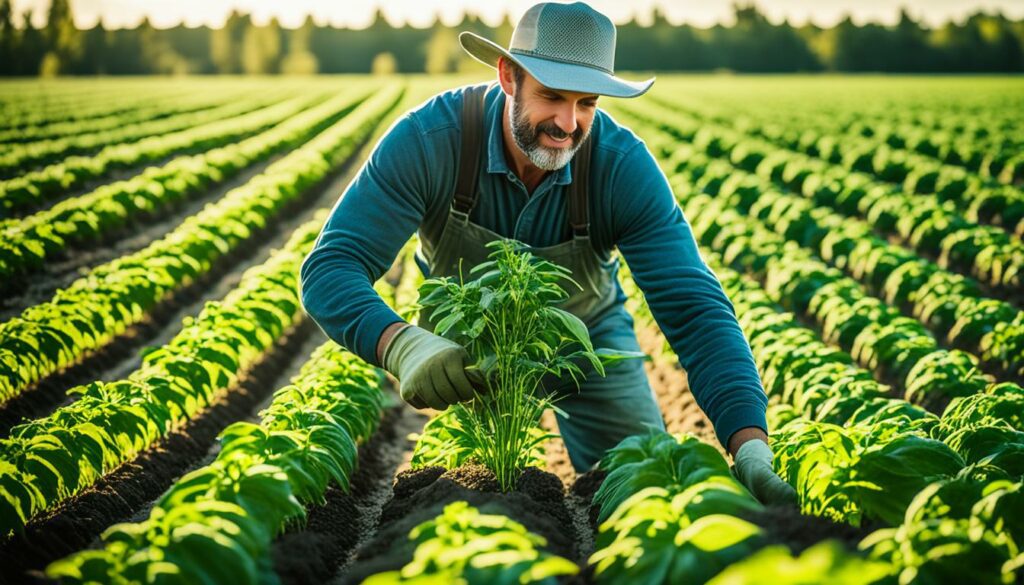
No-till farming is great because it doesn’t disturb the soil much, so less weed seeds grow. Digging the soil makes weed seeds start to grow. No-till farming avoids this, making the soil happy.
For slow-growing crops like onions and carrots that don’t cover the ground well, no-till methods are key. They help reduce weed seeds. Planting cover crops between main crops also stops late weeds from growing. This makes the whole weed controlling process better.
| Strategy | Benefits |
|---|---|
| Diverse Crop Rotations | Lowers densities of problem weeds, enhances soil health |
| High-Density Cover Crops | Competitive against weeds, improves weed suppression |
| No-Till Farming | Minimises weed seed germination, promotes soil harmony |
| Interseeding Standing Crops | Suppresses late-emerging weeds |
Crop rotation is key to using water wisely, making soil healthier and crops stronger in dry times. It boosts soil health and cuts down water needs. This happens by keeping more water in the earth, needing less from us.
Soil organic matter is vital for efficient water use. A good crop rotation plan helps soil keep more water. Studies in Central Anatolia, Turkey, found crops did better with rotation than growing wheat all the time.
Crop rotation doesn’t just save water on the surface. It also keeps moisture in deep soil. Research in Western Australia found soils had the same water, whether crops were rotated or not. This shows deep-rooted crop planning saves water, especially in droughts.
The table below details comparative findings on water use efficiency from various global studies:
| Country | Crop Sequence | Water Use Efficiency | Key Findings |
|---|---|---|---|
| Turkey | Rotations vs Continuous Wheat | Higher in Rotations | Increased efficiency observed in rotated plots |
| Spain | Rotations vs Continuous Wheat | Lower in Rotations | Continuous wheat showed better efficiency |
| Australia | Rotations vs Continuous Crops | Similar | No significant difference in water amounts |
| China | Various | Improved over 50 years | Efficiency increased due to temperature and precipitation dynamics |
Crop rotation boosts the economy and protects our environment. It helps farmers and the nature around them. This approach supports both crops and the living eco-systems nearby.
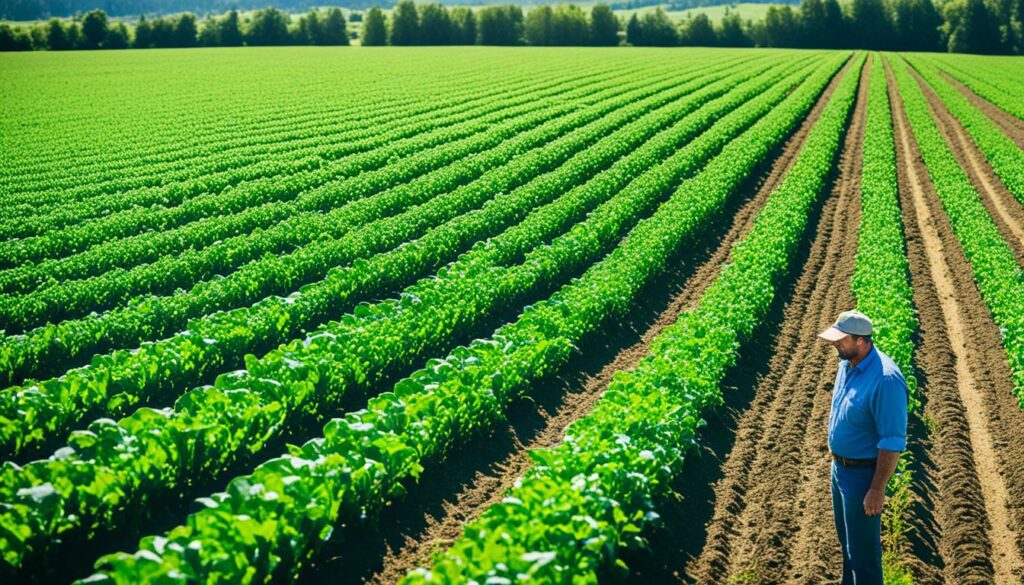
Crop rotation cuts spending on fertilisers. For instance, planting legumes helps the soil fix nitrogen naturally. This means farmers can use less artificial fertilisers, saving them money. Also, crops like soybeans add nutrients to the soil. This means farmers need fewer commercial fertilisers.
Environmental benefits of crop rotation are huge. It boosts soil’s health and structure, making room for good bacteria. This improves soil quality without compacting it. Also, grains like maize protect the ground and its nutrients. Perennial grasses do the same for water sources, keeping them clean. These actions support healthier ecosystems.
| Benefit | Economic Impact | Environmental Impact |
|---|---|---|
| Reduced Fertiliser Costs | Lower production expenses | Less chemical runoff |
| Improved Soil Health | Increased productivity and yield | Enhanced biodiversity |
| Reduction in Pesticides | Cost savings | Lower environmental toxicity |
Changing crop types can break the cycle of pests and diseases. This lowers pesticide use and supports a diverse environment. Crop rotation is key for both the economy and our planet. It is a vital part of sustainable farming.
Implementing crop rotation well is not easy. It involves a lot of knowledge and the need to grow different crops. Farmers must be skilled in using good farming methods. They also need to know what each crop needs.
To do crop rotation, farmers need to understand soil, climate, and what plants need. This knowledge helps shape the soil and how crops grow, according to Ball et al. (2005)’s research. Using grass and making smart crop plans can help against problems like soil erosion, as Jankauskas & Jankauskiene (2003) point out.
Growing different crops in rotation improves the system and the harvest, according to Li et al. (2019). But, this can mean spending more on equipment and learning a lot. Crops like soybeans and alfalfa are great at keeping the soil healthy and using water right, says Mohler & Johnson (2009). Choosing a mix of crops also helps fight off pests and diseases without using lots of chemicals, as Simić et al. (2016) state.
Crop rotation is key in farming because it helps the environment and the economy. But, making it work needs farmers to keep learning and trying new plant mixes. This way, they can make their farms both green and profitable.
| Farmer Size | Challenges | Solutions |
|---|---|---|
| Large Farms | Complexity of managing multiyear rotations | Use of advanced machinery and specialised education |
| Small Farms (<5 acres) | Incorporating cover crops, adequate crop rotation | Reliance on mulch, compost, and short-term cover crops |
| General Farmers | Adapting to seasonal and field conditions | Frequent adjustment of rotational plans |
Starting an effective crop rotation needs you to really know your soil. This includes finding what the soil needs and picking the right crops to grow.

Begin by looking at what your soil needs. Every field is different. For example, planting maize can protect the soil on top. But adding tofu soybeans can help corn grow because they boost nitrogen levels.
It’s also important not to grow the same crops year after year. And avoid planting in rows on hills. This keeps the soil in top shape all year.
It’s key to pick the right crop families for a good rotation. Small Valley Farm, for instance, grows tofu soybeans, corn, oat/clover/spelt, and hay in a cycle. This happens every four years.
Knowing the best mix helps keep the soil healthy. It reduces the risk of diseases too. Using different plants that fix nitrogen cuts down on single crop farming. This makes planning easier and the land more sustainable.
Using tools like Microsoft Excel helps with complex plans. It’s good for keeping planting and harvest times straight. This can be early or late spring.
By organising all this info well, you set your crop rotation up for success. Every part of growing and caring for your crops should fit together just right.
“Crop rotation is not just about shifting plants; it’s about strategically leveraging nature’s systems to optimize yield and maintain soil health,” – Agriculture Extension Service.
Dirk Peterson’s journey in crop rotation shows how one farmer can make a big change. He moved his family farm in Minnesota to organic methods in 2004. By 2014, 360 acres of his farm were certified as organic. Out of these, 280 acres were his own, and 80 were rented.
He achieved this through careful planning and hard work. Starting out, the organic corn on his farm yielded between 165 to 185 bushels per acre. After a few years, he was growing organic corn, soybeans, oats, winter wheat, and canning peas. Corn was his main crop, producing about 145 bushels per acre.
Dirk also became involved in sustainable agriculture in more ways. Since 2008, he’s been running a seed-testing programme. His efforts with cover crops began in 2010.
He first tried oilseed radish after oats. Then, he added annual ryegrass and hairy vetch but faced challenges due to heavy rains, which caused flooding in September 2011.
But Dirk didn’t give up. In 2012, he planted a cover crop of oats across his land. Later, he tried winter cereal rye after his organic corn. Even though the weather posed problems, he kept on experimenting with cover crops from 2013 to 2014.
The table below shows how Dirk’s approach to crop rotation impacted his finances:
| Crop | Net Return (Per Acre) |
|---|---|
| Onions | $14,000 |
| Lettuce | $9,000 |
| Rotation No. 1 (Avg) | $17,592 |
| Rotation No. 2 (Avg) | $20,964 |
This data shows the benefits of good crop rotation. Over a three-year period, onions gave the best return at over $14,000 an acre. Lettuce was next with $9,000 an acre. These results highlight the value of crop rotations in profitable and sustainable farming.
In North Dakota, crop rotation has evolved. Farmers now grow corn and soybeans alongside the traditional wheat, barley, and others. This change highlights the benefits of a customised crop rotation. It helps improve crop yield and keeps farms sustainable. Using a mix of broadleaf and grass crops, such as those farms growing four types, boosts the soil’s health and water use.
Sunflowers and wheat play important roles in this. Sunflowers use up leftover nitrogen from corn. Wheat, planted in the same field after sunflowers, grows well thanks to its cool needs. Soybeans and corn are also key. Soybeans are versatile, fitting many planting times. Corn, while needing careful handling because of its longer growing season, brings high yields.
Crop rotation is vital for farming sustainability. It helps choose what to plant based on soil, water, and previous crop leftovers. With better yields, less need for chemicals, and soil erosion control, the benefits are huge. For small farms, changing crops smartly can bring in more money and help the environment. This ensures the soil stays healthy for the long term and farming succeeds.
Seasonal crop rotation is a farming method. It means growing different crops in the same area but at different times. By doing this, farmers keep the soil healthy and reduce the need for chemicals. It also helps control weeds.
It boosts soil fertility by mixing up the nutrients in the soil. For instance, plants like legumes put nitrogen back into the soil, which helps other crops grow. This method also makes the soil better for seeds to grow and for roots to spread.
There are many good things about using crop rotation. It makes the soil richer, which means better crops. This method beats bugs and diseases in a natural way. The land gets stronger and healthier. Plus, it helps the Earth by using fewer chemicals.
It stops soil from washing away by using smart plant choices. Some plants have deep roots that make the soil hold together better. Others, like maize, keep the topsoil safe by covering it. This means less soil gets blown or washed away.
Definitely, it makes sure plants get the nutrients they need. Some plants, like legumes, help by putting nitrogen back into the ground. Having different types of crops also means more nutrients are available for each plant.
It confuses pests and diseases, making it harder for them to find their favourite plants. This lowers the need for harmful sprays. It is a smart way to protect the crops and the environment at the same time.
It saves money by reducing the use of chemicals. This leads to better harvests too. With healthier soil, farms are more stable against risks. So, in the end, farmers make more money by spending less on inputs.
It needs a lot of know-how to do it right. Farmers must understand what each crop likes and what the soil needs. They also need the right tools and training to handle different kinds of plants well.
First, figure out what your soil needs. Then, choose crops that work well together. The order in which you plant them matters too. Keep in mind, the goal is to make the soil and your crops as healthy as possible.
Yes, many farmers have shown that crop rotation works. They have found it’s a great way to make a living while taking care of the planet. Their stories prove that smart farming not only makes sense but also makes money.